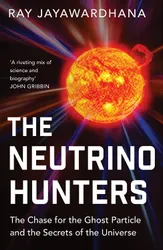This book describes the story of the neutrino from its original conception, the quest to build working neutrino detectors, and the things scientists have learned from being able to detect neutrinos. As the book progresses, neutrino detection becomes more sophisticated, at first only being able to detect one type of neutrino, through the realisation that there are different types, and being able to detect those types with increasing sensitivity.
The neutrino is a particle emitted from some nuclear reactions, and was invented as a theoretical idea in order to preserve energy conservation in these reactions. It was originally thought that it was impossible to ever detect, due to it not having a charge and not interacting easily with anything. But ideas were put forward of ways in which it might theoretically be detected, and eventually these were implemented in practical detectors that began to detect neutrinos.
In telling the story, the book describes many of the scientists involved in both the theoretical and practical aspects of neutrino physics. There are some interesting characters with a bit of mystery in this book. Bruno Pontecorvo, who devised a possible neutrino detection method and proposed the idea of neutrino oscillation in which neutrinos can change their type spontaneously, appears to have defected to the Soviet Union in 1950. And Ettore Majorana, who also made some important contributions, disappeared mysteriously in 1938, presumed to have killed himself. Interestingly though, the Wikipedia page for Majorana suggests that some evidence emerged in 2015 (after this book was written) that he may have been alive as late as 1959. Other scientists in the book live more conventional lives but are interesting to read about anyway.
The Neutrino Hunters also covers the implications and usefulness of being able to detect neutrinos for astronomy. Since stars are nuclear reactions, they emit neutrinos in great quantities, and events like a star going supernova emit even more. I was interested to learn that we can detect neutrinos from a supernova before we receive any light, because the photons interact with the material in the star and can take a long time to escape. The neutrinos, on the other hand, very rarely interact with matter, and travel at almost the speed of light. So neutrino detectors can act as an early warning system for supernovae, allowing astronomers to point their telescopes at the right area of the sky to observe the visible light when it arrives.
Towards the end of the book, the possible implications of the knowledge we’ve gained about neutrinos is discussed. One is that the neutrino has a tiny but non-zero mass, and this implies that the standard model of particle physics isn’t completely correct. This opens up the possibility of physics beyond the standard model. Another is that neutrino behaviour may be able to resolve the question of why our universe is dominated by matter, when we might expect an equal amount of antimatter to have existed at the start of the universe. This would have annihilated with the matter to produce only energy. So something caused matter to dominate, even if only slightly, and the book explains how neutrinos may have played a role in this. The author also speculates on some possible future uses of neutrinos and neutrino detectors. Could neutrinos be used for communication, in situations where a radio signal would be blocked, such as by sending neutrino signals directly through the earth? Another idea is to use neutrino detectors to ensure compliance with nuclear proliferation treaties, as the reactions used for enrichment of nuclear material for weapons would give out a detectable neutrino signal.
This book is a fairly straightforward history of the field of neutrino physics and detection. But it’s a really interesting subject to read about and the book is enjoyable to read. I enjoyed the way the physics was covered, including how neutrinos can be made to interact with matter, thus allowing them to be detected - a tiny fraction of them, anyway! There are some good diagrams to help explain the process. There are also photos of the main scientists described in the text, and of the detectors themselves, which helped me to visualise what was going on.
The book was published in 2014 and this field seems to move fairly fast. One discovery that does date this book is that it mentions the LIGO experiment, but was published before LIGO had made its first detection of gravitational waves in 2016. So I’d be interested to read a more recent book about neutrinos to see if anything new has been discovered. But this book is a good introduction to the subject.
